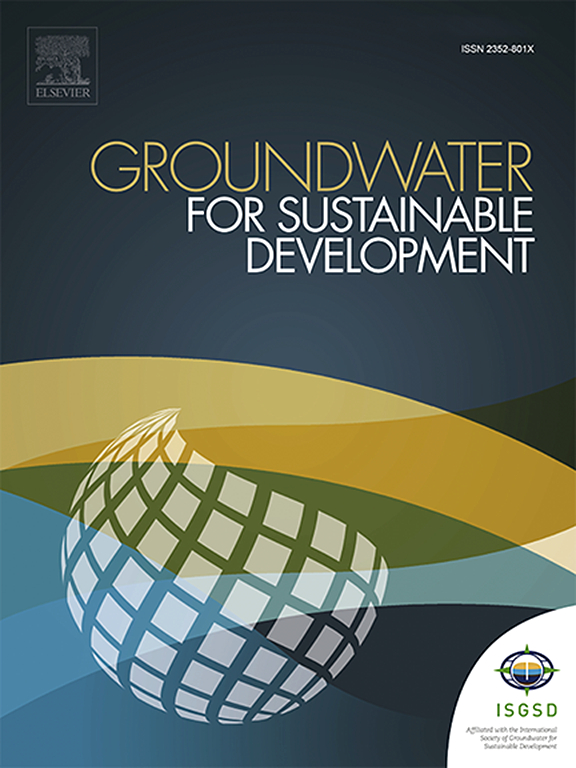Groundwater vulnerability assessment using modified DRASTIC method with integrated hydrological model
IF 4.9
Q2 ENGINEERING, ENVIRONMENTAL
引用次数: 0
Abstract
Since groundwater is a finite resource, assessing its vulnerability to pollution is crucial for sustainable management. Contamination poses a significant threat, potentially degrading both the quality and quantity of available groundwater. To enhance the efficiency of this vital tool in subsurface water management, this study aims to propose the approach integrating index-based vulnerability assessment (DRASTIC-L) with fully coupled surface water-groundwater model (SWAT-MODFLOW). Various thematic layers regarding hydrogeological characteristics and land use of the Yom and Nan River basins are analyzed and overlaid to calculate the weighted index as well as identify vulnerability classes. DRASTIC-L components (depth to water table, recharge, and hydraulic conductivity) are directly simulated by SWAT-MODFLOW, instead of using interpolated observation data. As a result, the high consistency between simulated river discharges and groundwater levels with observed data implies a high degree of accuracy in the vulnerability parameters obtained from the model. DRASTIC-L index ranges from 61 to 221, classifying the study area into four vulnerability categories: low (<100), moderate (100–140), high (140–200), and very high (>200). 15.8% of the watershed exhibits low susceptibility, while moderate susceptibility characterizes 36.9%. Notably, 42.4% of the area falls within the highly susceptible category, highlighting potential contamination risks. Very highly susceptible zones comprise a smaller portion (4.7%) of the watershed. Moreover, Nitrate concentration data shows spatial congruence with areas designated as highly vulnerable. By providing a more accurate characterization of aquifer vulnerability, this approach can inform decision-makers in developing targeted and efficient plans to protect both groundwater quantity and quality.

基于综合水文模型的改进DRASTIC方法评价地下水脆弱性
由于地下水是一种有限资源,评估其易受污染的程度对可持续管理至关重要。污染构成了重大威胁,可能会降低可用地下水的质量和数量。为了提高这一重要工具在地下水管理中的效率,本研究旨在提出将基于指数的脆弱性评估(DRASTIC-L)与地表水-地下水完全耦合模型(SWAT-MODFLOW)相结合的方法。对滇南流域水文地质特征和土地利用等各主题层进行分析叠加,计算加权指数,识别脆弱性等级。SWAT-MODFLOW直接模拟了DRASTIC-L分量(深度到地下水位、补给和水力导电性),而不是使用插值观测数据。因此,模拟河流流量和地下水位与观测数据的高度一致性意味着从模型中获得的脆弱性参数具有很高的准确性。DRASTIC-L指数的取值范围为61 ~ 221,将研究区划分为低(<100)、中(100 - 140)、高(140-200)和极高(>200)四个脆弱性类别。低易感性占15.8%,中等易感性占36.9%。值得注意的是,42.4%的地区属于高度易感类别,突出了潜在的污染风险。高度易感区占流域的一小部分(4.7%)。此外,硝酸盐浓度数据与指定为高度脆弱区域的空间一致性。通过提供更准确的含水层脆弱性特征,该方法可以为决策者提供有针对性和有效的计划,以保护地下水的数量和质量。
本文章由计算机程序翻译,如有差异,请以英文原文为准。
求助全文
约1分钟内获得全文
求助全文
来源期刊

Groundwater for Sustainable Development
Social Sciences-Geography, Planning and Development
CiteScore
11.50
自引率
10.20%
发文量
152
期刊介绍:
Groundwater for Sustainable Development is directed to different stakeholders and professionals, including government and non-governmental organizations, international funding agencies, universities, public water institutions, public health and other public/private sector professionals, and other relevant institutions. It is aimed at professionals, academics and students in the fields of disciplines such as: groundwater and its connection to surface hydrology and environment, soil sciences, engineering, ecology, microbiology, atmospheric sciences, analytical chemistry, hydro-engineering, water technology, environmental ethics, economics, public health, policy, as well as social sciences, legal disciplines, or any other area connected with water issues. The objectives of this journal are to facilitate: • The improvement of effective and sustainable management of water resources across the globe. • The improvement of human access to groundwater resources in adequate quantity and good quality. • The meeting of the increasing demand for drinking and irrigation water needed for food security to contribute to a social and economically sound human development. • The creation of a global inter- and multidisciplinary platform and forum to improve our understanding of groundwater resources and to advocate their effective and sustainable management and protection against contamination. • Interdisciplinary information exchange and to stimulate scientific research in the fields of groundwater related sciences and social and health sciences required to achieve the United Nations Millennium Development Goals for sustainable development.
 求助内容:
求助内容: 应助结果提醒方式:
应助结果提醒方式:


